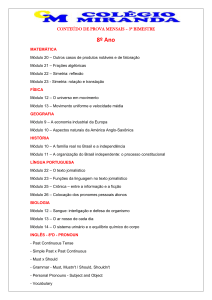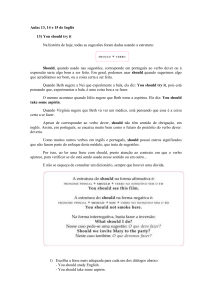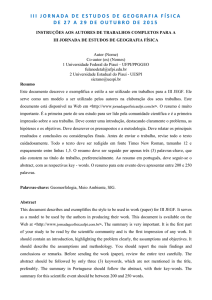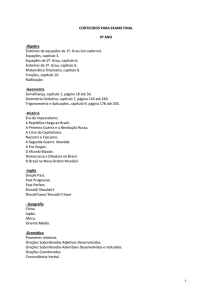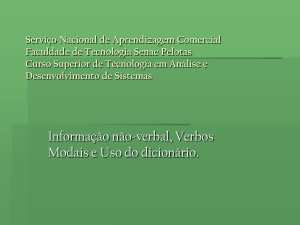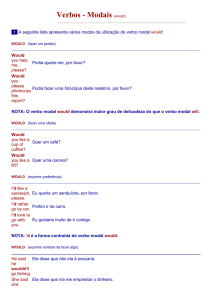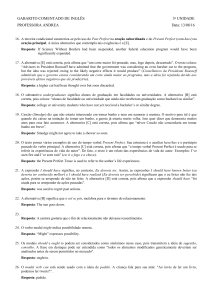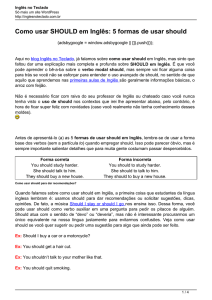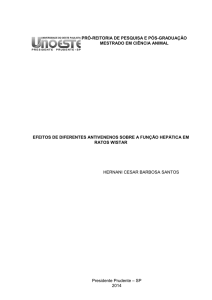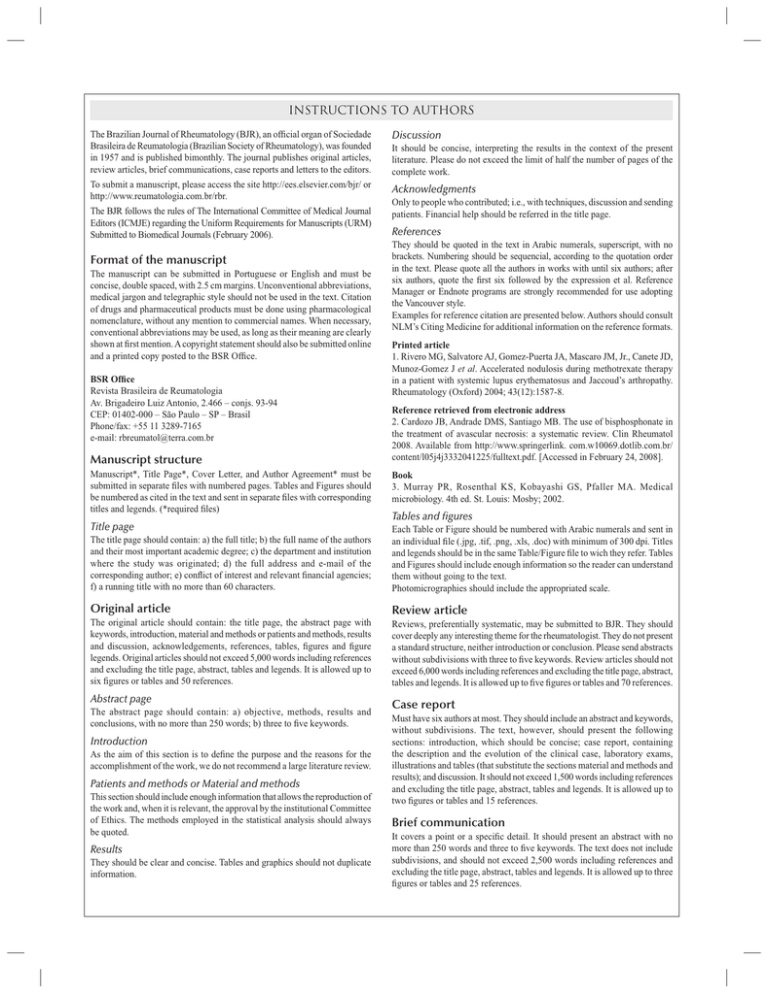
INSTRUCTIONS TO AUTHORS
The Brazilian Journal of Rheumatology (BJR), an official organ of Sociedade
Brasileira de Reumatologia (Brazilian Society of Rheumatology), was founded
in 1957 and is published bimonthly. The journal publishes original articles,
review articles, brief communications, case reports and letters to the editors.
Discussion
To submit a manuscript, please access the site http://ees.elsevier.com/bjr/ or
http://www.reumatologia.com.br/rbr.
Acknowledgments
The BJR follows the rules of The International Committee of Medical Journal
Editors (ICMJE) regarding the Uniform Requirements for Manuscripts (URM)
Submitted to Biomedical Journals (February 2006).
Format of the manuscript
The manuscript can be submitted in Portuguese or English and must be
concise, double spaced, with 2.5 cm margins. Unconventional abbreviations,
medical jargon and telegraphic style should not be used in the text. Citation
of drugs and pharmaceutical products must be done using pharmacological
nomenclature, without any mention to commercial names. When necessary,
conventional abbreviations may be used, as long as their meaning are clearly
shown at first mention. A copyright statement should also be submitted online
and a printed copy posted to the BSR Office.
BSR Office
Revista Brasileira de Reumatologia
Av. Brigadeiro Luiz Antonio, 2.466 – conjs. 93-94
CEP: 01402-000 – São Paulo – SP – Brasil
Phone/fax: +55 11 3289-7165
e-mail: [email protected]
Manuscript structure
It should be concise, interpreting the results in the context of the present
literature. Please do not exceed the limit of half the number of pages of the
complete work.
Only to people who contributed; i.e., with techniques, discussion and sending
patients. Financial help should be referred in the title page.
References
They should be quoted in the text in Arabic numerals, superscript, with no
brackets. Numbering should be sequencial, according to the quotation order
in the text. Please quote all the authors in works with until six authors; after
six authors, quote the first six followed by the expression et al. Reference
Manager or Endnote programs are strongly recommended for use adopting
the Vancouver style.
Examples for reference citation are presented below. Authors should consult
NLM’s Citing Medicine for additional information on the reference formats.
Printed article
1. Rivero MG, Salvatore AJ, Gomez-Puerta JA, Mascaro JM, Jr., Canete JD,
Munoz-Gomez J et al. Accelerated nodulosis during methotrexate therapy
in a patient with systemic lupus erythematosus and Jaccoud’s arthropathy.
Rheumatology (Oxford) 2004; 43(12):1587-8.
Reference retrieved from electronic address
2. Cardozo JB, Andrade DMS, Santiago MB. The use of bisphosphonate in
the treatment of avascular necrosis: a systematic review. Clin Rheumatol
2008. Available from http://www.springerlink. com.w10069.dotlib.com.br/
content/l05j4j3332041225/fulltext.pdf. [Accessed in February 24, 2008].
Manuscript*, Title Page*, Cover Letter, and Author Agreement* must be
submitted in separate files with numbered pages. Tables and Figures should
be numbered as cited in the text and sent in separate files with corresponding
titles and legends. (*required files)
Book
3. Murray PR, Rosenthal KS, Kobayashi GS, Pfaller MA. Medical
microbiology. 4th ed. St. Louis: Mosby; 2002.
Title page
The title page should contain: a) the full title; b) the full name of the authors
and their most important academic degree; c) the department and institution
where the study was originated; d) the full address and e-mail of the
corresponding author; e) conflict of interest and relevant financial agencies;
f) a running title with no more than 60 characters.
Each Table or Figure should be numbered with Arabic numerals and sent in
an individual file (.jpg, .tif, .png, .xls, .doc) with minimum of 300 dpi. Titles
and legends should be in the same Table/Figure file to wich they refer. Tables
and Figures should include enough information so the reader can understand
them without going to the text.
Photomicrographies should include the appropriated scale.
Original article
Review article
The original article should contain: the title page, the abstract page with
keywords, introduction, material and methods or patients and methods, results
and discussion, acknowledgements, references, tables, figures and figure
legends. Original articles should not exceed 5,000 words including references
and excluding the title page, abstract, tables and legends. It is allowed up to
six figures or tables and 50 references.
Reviews, preferentially systematic, may be submitted to BJR. They should
cover deeply any interesting theme for the rheumatologist. They do not present
a standard structure, neither introduction or conclusion. Please send abstracts
without subdivisions with three to five keywords. Review articles should not
exceed 6,000 words including references and excluding the title page, abstract,
tables and legends. It is allowed up to five figures or tables and 70 references.
Abstract page
The abstract page should contain: a) objective, methods, results and
conclusions, with no more than 250 words; b) three to five keywords.
Introduction
As the aim of this section is to define the purpose and the reasons for the
accomplishment of the work, we do not recommend a large literature review.
Patients and methods or Material and methods
This section should include enough information that allows the reproduction of
the work and, when it is relevant, the approval by the institutional Committee
of Ethics. The methods employed in the statistical analysis should always
be quoted.
Results
They should be clear and concise. Tables and graphics should not duplicate
information.
Tables and figures
Case report
Must have six authors at most. They should include an abstract and keywords,
without subdivisions. The text, however, should present the following
sections: introduction, which should be concise; case report, containing
the description and the evolution of the clinical case, laboratory exams,
illustrations and tables (that substitute the sections material and methods and
results); and discussion. It should not exceed 1,500 words including references
and excluding the title page, abstract, tables and legends. It is allowed up to
two figures or tables and 15 references.
Brief communication
It covers a point or a specific detail. It should present an abstract with no
more than 250 words and three to five keywords. The text does not include
subdivisions, and should not exceed 2,500 words including references and
excluding the title page, abstract, tables and legends. It is allowed up to three
figures or tables and 25 references.
Rules for applying the appropriate tense in scientific writing
Context or section
Appropriate verb tense
Abstract
Past tense
Introduction
Most present tense (established facts,
previous published data)
Methods, materials used,
and results
Past tense
Discussion/Conclusion
Mixture of past and present, sometimes
future tense
Attribution
Past tense
Ex.: Andrade et al. reported that...
Description of Tables and
Figures
Present tense
Established knowledge,
previous results etc.
Present tense
General rules to obtain a good scientific writing:
1. Use active voice. Avoid overuse of passive voice.
2. Setences must be short.
3. Units of measurement are abbreviated when use with numerical values
(e.g., 1 mg), but are not abbreviated if used without numerical values.
Systeme International d'Únites (SI units) must be used. Remember to
leave a space between the number and unit (e.g., 10 mg/dL), except for
the percentage mark that follows the number without space (e.g., 70%).
The plural form of units of measurement is the same as the singular form
(e.g., 1 mL, 10 mL; 1 h, 10 h). Spell out numbers at the beginning of a
sentence.
4. Define abbreviations the first time they appear. Avoid abbreviations in
tittles and abstracts.
5. Do not use contractions (e.g., doesn't, can't etc.).
Recommended book: Rogers SM. Mastering scientific and medical writing:
a self-help guide. Berlin: Springer; 2007.
Legal and ethical considerations
According to the Uniform Requirements for Manuscripts Submitted to
Biomedical Journals (International Committee of Medical Journal Editors –
February 2006).
Conflict of interest
Public trust in the peer review process and the credibility of published
articles depend in part on how well conflict of interest is handled during
writing, peer review, and editorial decision making. Conflict of interest
exists when an author (or the author’s institution), reviewer, or editor has
financial or personal relationships that inappropriately influence (bias) his
or her actions (such relationships are also known as dual commitments,
competing interests, or competing loyalties). These relationships vary
from those with negligible potential to those with great potential to
influence judgment, and not all relationships represent true conflict of
interest. The potential for conflict of interest can exist whether or not
an individual believes that the relationship affects his or her scientific
judgment. Financial relationships (such as employment, consultancies,
stock ownership, honoraria, paid expert testimony) are the most easily
identifiable conflicts of interest and the most likely to undermine the
credibility of the journal, the authors, and of science itself. However,
conflicts can occur for other reasons, such as personal relationships,
academic competition, and intellectual passion.
Informed consent
Patients have a right to privacy, that should not be infringed without
informed consent. Identifying information, including patients’ names,
initials, or hospital numbers, should not be published in written descriptions,
photographs, and pedigrees unless the information is essential for scientific
purposes and the patient (or parent or guardian) gives written informed
consent for publication. Informed consent for this purpose requires that a
patient who is identifiable be shown the manuscript to be published. Authors
should identify Individuals who provide writing assistance and disclose the
funding source for this assistance. Identifying details should be omitted if
they are not essential.
Complete anonymity is difficult to achieve. However, an informed consent
should be obtained if there is any doubt. For example, masking the eye
region in photographs of patients is inadequate protection of anonymity. If
identifying characteristics are altered to protect anonymity, such as in genetic
pedigrees, authors should provide assurance that alterations do not distort
scientific meaning and editors should so note. When informed consent has
been obtained it should be indicated in the published article.
Ethical treatment
When reporting experiments on human subjects, authors should indicate
whether the procedures followed were in accordance with the ethical
standards of the responsible committee on human experimentation
(institutional and national) and with the Helsinki Declaration of 1975, as
revised in 2000. If doubt exists whether the research was conducted in
accordance with the Helsinki Declaration, the authors must explain the
rationale for their approach, and demonstrate that the institutional review
body explicitly approved the doubtful aspects of the study. When reporting
experiments on animals, authors should be asked to indicate whether the
institutional and national guide for the care and use of laboratory animals
was followed.
Clinical trials registry
Clinical trials must be registered according to WHO recommendation at www.
who.int/ictrp/en/. The definition of clinical trial include preliminary trials
(phase I): any study with prospective recruiting of subjects to undergo any
health-related intervention (drugs, surgical procedures, equipment, behavioral
therapies, food regimen, changes in health care) to evaluate the effects on
clinical outcomes (any biomedical or health-related parameter, including
pharmacokinetics measurements and adverse reactions).
The BJR has the right not to publish trials not complying with these and
other legal and ethical standards determined by international guidelines.
Financing and support
The authors should also inform if they received financing or support
from institutions like CNPq, CAPES, SBR Remaining Funds, Graduated
Institutions, Laboratories etc.
INSTRUÇÕES PARA OS AUTORES
A Revista Brasileira de Reumatologia (RBR), órgão oficial da Sociedade Brasileira de Reumatologia, foi fundada em 1957 e é publicada bimestralmente.
A revista publica artigos originais, artigos de revisão, comunicações breves,
relatos de casos e cartas aos editores.
A submissão dos manuscritos deve ser realizada online pelos sites:
http://ees.elsevier.com/bjr/ ou www.reumatologia.com.br/rbr.
A RBR segue as normas do Uniform Requirements for Manuscripts (URM)
Submitted to Biomedical Journals desenvolvidas pelo The International
Committee of Medical Journal Editors (ICMJE) – fevereiro de 2006.
Apresentação do manuscrito
O manuscrito pode ser submetido em português ou inglês e deve ser
conciso, em espaço duplo, com margens de 2,5 cm. No texto não devem ser empregadas abreviaturas não convencionais, gírias (jargões)
médicas ou redação tipo telegráfica. A citação de medicamentos e produtos farmacêuticos deve ser feita utilizando-se apenas a nomenclatura
farmacológica, sem menção do nome comercial. Quando necessário, é
possível utilizar abreviaturas convencionais, desde que o significado
apareça por extenso pelo menos na primeira vez em que forem citadas.
Uma autorização para publicação do manuscrito (Author Agreement)
deve ser enviada online no ato da submissão, e uma cópia impressa
enviada para a Secretaria da SBR.
Secretaria Editorial RBR
Revista Brasileira de Reumatologia
Av. Brigadeiro Luiz Antonio, 2.466 – conjs. 93-94
CEP: 01402-000 – São Paulo – SP – Brasil
Tel./fax: (11) 3289-7165
e-mail: [email protected]
Estrutura do manuscrito
Manuscript*, Title Page*, Cover Letter e Author Agreement* devem ser
enviados em arquivos separados, com páginas numeradas. Tabelas e figuras
devem ser numeradas conforme citadas no texto e enviadas em arquivos
separados, com títulos e legendas correspondentes. (*arquivos obrigatórios)
Página do título
Deve conter: a) título do artigo; b) nome completo dos autores e sua titulação
mais importante; c) departamento(s) e instituição(ões) onde se originou o trabalho; d) nome, endereço completo e e-mail válido do autor responsável para
correspondência; e) conflito de interesse e agências financiadoras relevantes;
f) título resumido com no máximo 60 caracteres.
Artigo Original
O artigo original deve conter: página do título, página de resumo com palavras-chave, introdução, material e métodos ou pacientes e métodos, resultados e
discussão, agradecimentos, referências, tabelas, figuras e legendas das figuras.
Não deve exceder 5.000 palavras, incluindo-se as referências e excluindo-se
a página do título, resumo, tabelas e legendas. Pode exibir até seis figuras ou
tabelas e até 50 referências.
Resultados
Devem ser claros e concisos. Tabelas e gráficos não devem duplicar informações.
Discussão
Deve ser concisa, interpretando os resultados no contexto da literatura atual. É
conveniente não ultrapassar a metade do número de páginas do trabalho completo.
Agradecimentos
Apenas às pessoas que contribuíram, por exemplo, com técnicas, discussão e
envio de pacientes. Auxílio financeiro deve ser referido na página do título.
Referências
Devem ser citadas no texto em algarismos arábicos, sobrescritos e depois da
pontuação, sem parênteses ou colchetes. A numeração deve ser sequencial,
de acordo com a ordem de citação no texto. Nas referências com mais de
seis autores, devem ser citados os seis primeiros, seguidos pela expressão
et al. Sugere-se a utilização dos programas Reference Manager ou Endnote,
seguindo-se o estilo Vancouver. Exemplos de referência para diferentes
formatos são apresentados a seguir. Os autores devem consultar o NLM’s
Citing Medicine para mais informações sobre os formatos das referências.
Artigo de revista
1. Rivero MG, Salvatore AJ, Gomez-Puerta JA, Mascaro JM, Jr., Canete JD,
Munoz-Gomez J et al. Accelerated nodulosis during methotrexate therapy
in a patient with systemic lupus erythematosus and Jaccoud’s arthropathy.
Rheumatology (Oxford) 2004; 43(12):1587-8.
Artigo extraído de endereço eletrônico
2. Cardozo JB, Andrade DMS, Santiago MB. The use of bisphosphonate in
the treatment of avascular necrosis: a systematic review. Clin Rheumatol
2008. Available from http://www.springerlink.com.w10069.dotlib.com.br/
content/l05j4j3332041225/fulltext. pdf. [Accessed in February 24, 2008].
Livro
3. Murray PR, Rosenthal KS, Kobayashi GS, Pfaller MA. Medical microbiology. 4th ed. St. Louis: Mosby; 2002.
Tabelas e Figuras
Cada tabela ou figura deverá ser numerada em algarismo arábico e enviada em
arquivo separado (.jpg, .tif, .png, .xls, .doc) com 300 dpi no mínimo. Título e
legenda devem estar no mesmo arquivo da figura ou tabela a que se referem.
Tabelas e ilustrações devem ser autoexplicativas, incluindo informações
suficientes para sua compreensão sem que se tenha de recorrer ao trabalho.
Fotomicrografias devem incluir a escala apropriada.
Artigo de Revisão
Revisões, preferencialmente sistemáticas, podem ser submetidas à RBR,
devendo abordar com profundidade um tema de interesse para o reumatologista. Não apresentam estruturação padronizada, prescindindo de introdução
ou discussão. Devem apresentar resumo sem subdivisões, com três a cinco
palavras-chave, e não devem exceder 6.000 palavras, incluindo-se as referências e excluindo-se a página do título, resumo, tabelas e legendas. Podem
exibir até cinco figuras ou tabelas e até 70 referências.
Relato de Caso
A finalidade dessa seção é definir o propósito e as razões para a realização
trabalho. Não se recomenda extensa revisão da literatura.
Deve incluir resumo e palavras-chave, sem necessidade de subdivisões. O texto,
porém, apresenta as seguintes seções: introdução, que deve ser concisa; relato de
caso, contendo a descrição e a evolução do quadro clínico, exames laboratoriais,
ilustrações e tabelas (que substituem as seções material e métodos e resultados);
e discussão. Deve conter no máximo seis autores, e não deve exceder 1.500
palavras, incluindo-se as referências e excluindo-se a página do título, resumo,
tabelas e legendas. Pode exibir até duas figuras ou tabelas e até 15 referências.
Pacientes e métodos ou Material e métodos
Comunicação breve
Deve incluir informações suficientes que permitam a reprodução do trabalho e,
quando pertinente, a aprovação pelo Comitê de Ética institucional. Os métodos
empregados na análise estatística devem sempre ser citados.
Aborda um ponto ou detalhe específico de um tema. Deve incluir resumo
com no máximo 250 palavras, e três a cinco palavras-chave. O texto não
necessita subdivisões, deve ter até 2.500 palavras incluindo-se as referências
e excluindo-se a página do título, resumo, tabelas e legendas. Pode exibir até
três figuras ou tabelas e até 25 referências.
Página de resumo
Deve conter: a) objetivo, métodos, resultados e conclusões, não excedendo
250 palavras; b) três a cinco palavras-chave.
Introdução
Regras para aplicar tempos verbais apropriados de acordo com
o contexto ou seção
Contexto ou seção
Resumo
Introdução
Métodos, materiais e
resultados
Discussão/Conclusão
Atribuições
Descrição de Tabelas e Figuras
Conhecimento estabelecido e
resultados prévios
Tempo verbal apropriado
Passado
Presente, quando se referir a fatos estabelecidos e conhecimento prévio
Passado
Combinado de passado (quando se referir a resultados obtidos no trabalho) e
presente (quando se referir a fatos estabelecidos e conhecimento prévio); às
vezes pode ser utilizado o futuro (especialmente quando se referir a perspectivas de trabalhos a serem realizados)
Passado
Ex.: Andrade et al. relataram...
Presente
Presente
Regras gerais para se obter uma boa escrita em um artigo científico:
1. Prefira a voz ativa. Evite excesso de uso da voz passiva.
2. As sentenças devem ser curtas. Evite sentenças longas e complicadas.
3. Inconsistência do uso de termos técnicos ou unidades. A unidade de
medida deve ser abreviada quando empregada com valores numéricos
(p. ex., 1 mg), mas escrita por extenso quando separada de valor
numérico. Utilize o Sistema Internacional de Unidades (SI units) para
definir as unidades de medida. Lembre-se de deixar um espaço entre o
número e a unidade (p. ex., 10 mg/dL), exceto quando for porcentagem,
que deve estar junto (p. ex., 70%). O plural das unidades de medida
é a mesma forma do singular (p. ex., 1 mL, 10 mL; 1 h, 10 h). Quando
iniciarem a frase, os números devem estar por extenso, e não em
algarismo arábico.
4. Defina a abreviação na primeira vez que aparecer no texto principal.
Após a definição, use sempre a abreviação em vez da forma por extenso.
Evite o uso de abreviações no título e no resumo.
5. Ao escrever em inglês, não utilize contrações (p. ex., prefira does not em
vez de doesn't).
Livro recomendado: Rogers SM. Mastering scientific and medical writing: a
self-help guide. Berlin: Springer; 2007.
Considerações éticas e legais
Segue as normas do Uniform Requirements for Manuscripts (URM) Submitted
to Biomedical Journals desenvolvidas pelo The International Committee of
Medical Journal Editors (ICMJE) – fevereiro de 2006.
Conflito de interesse
A confiança pública no processo de revisão por pares e a credibilidade
dos artigos publicados dependem, em parte, de como o conflito de
interesse é administrado durante a redação, a revisão por pares e a
decisão editorial. O conflito de interesse existe quando um autor (ou
instituição do autor), revisor ou editor tem relações financeiras ou
pessoais que influenciem de forma inadequada (viés) suas ações (tais
relações são também conhecidas como duplo compromisso, interesses
conflitantes ou fidelidades conflitantes). Essas relações variam entre
aquelas com potencial insignificante até as com grande potencial
para influenciar o julgamento, e nem todas as relações representam
verdadeiro conflito de interesse. O potencial conflito de interesse pode
existir dependendo se o indivíduo acredita ou não que a relação afete
seu julgamento científico. Relações financeiras (tais como emprego, consultorias, posse de ações, testemunho de especialista pago) são os conflitos
de interesse mais facilmente identificáveis e os mais suscetíveis de minar a
credibilidade da revista, dos autores e da própria ciência. No entanto, podem
ocorrer conflitos por outras razões, tais como relações pessoais, competição
acadêmica e paixão intelectual.
Consentimento informado
Os pacientes têm o direito à privacidade, que não deve ser infringida
sem o consentimento informado. A identificação de informações,
incluindo os nomes dos pacientes, iniciais ou números no hospital,
não devem ser publicadas em descrições, fotografias e genealogias, a
menos que a informação seja essencial para os propósitos científicos
e o paciente (ou responsável) dê o consentimento livre e esclarecido
para a publicação.
O consentimento informado para este propósito requer que o manuscrito
a ser publicado seja mostrado ao paciente. Os autores devem identificar
os indivíduos que prestam assistência a escrever e divulgar a fonte de
financiamento para essa assistência. Detalhes identificadores devem ser
omitidos se não são essenciais.
O anonimato completo é difícil de se conseguir; no entanto, no caso
de qualquer dúvida, o consentimento deve ser obtido. Por exemplo,
mascarar a região ocular em fotografias de pacientes é uma proteção
de anonimato inadequada. Se as características de identificação são
alteradas para proteger o anonimato, como na linhagem genética, os
autores devem garantir que as alterações não distorçam o significado
científico. Quando o consentimento informado foi obtido, ele deve ser
indicado no artigo publicado.
Princípios éticos
Ao relatar experimentos em seres humanos, os autores devem indicar
se os procedimentos seguidos estiveram de acordo com os padrões
éticos do comitê responsável por experimentação humana (institucional e nacional) e com a Declaração de Helsinki de 1975, revisado em
2000. Se houver dúvida se a pesquisa foi realizada em conformidade
com a Declaração de Helsinki, os autores devem explicar a razão
para sua abordagem e demonstrar que o corpo de revisão institucional
aprovou explicitamente os aspectos duvidosos do estudo. Ao relatar
experimentos com animais, os autores devem indicar se as orientações
institucionais e nacionais para o cuidado e a utilização de animais de
laboratório foram seguidas.
Registro de ensaios clínicos
Os ensaios clínicos devem ser registrados segundo recomendação da
OMS em www.who.int/ictrp/en/. A definição de ensaios clínicos incluem ensaios preliminares (fase I): um estudo prospectivo com o
recrutamento de indivíduos submetidos a qualquer intervenção relacionada à saúde (medicamentos, procedimentos cirúrgicos, aparelhos,
terapias comportamentais, regime alimentar, mudanças nos cuidados
de saúde) para avaliar os efeitos em desfechos clínicos (qualquer
parâmetro biomédico e de saúde, inclusive medidas farmacocinéticas
e reações adversas).
A RBR tem o direito de não publicar trabalhos que não cumpram estas
e outras normas legais e éticas explicitadas nas diretrizes internacionais.
Financiamento e apoio
Os autores devem, também, informar se receberam financiamento ou apoio
de instituições como CNPq, CAPES, Fundos Remanescentes da SBR,
instituições universitárias, laboratórios etc.

